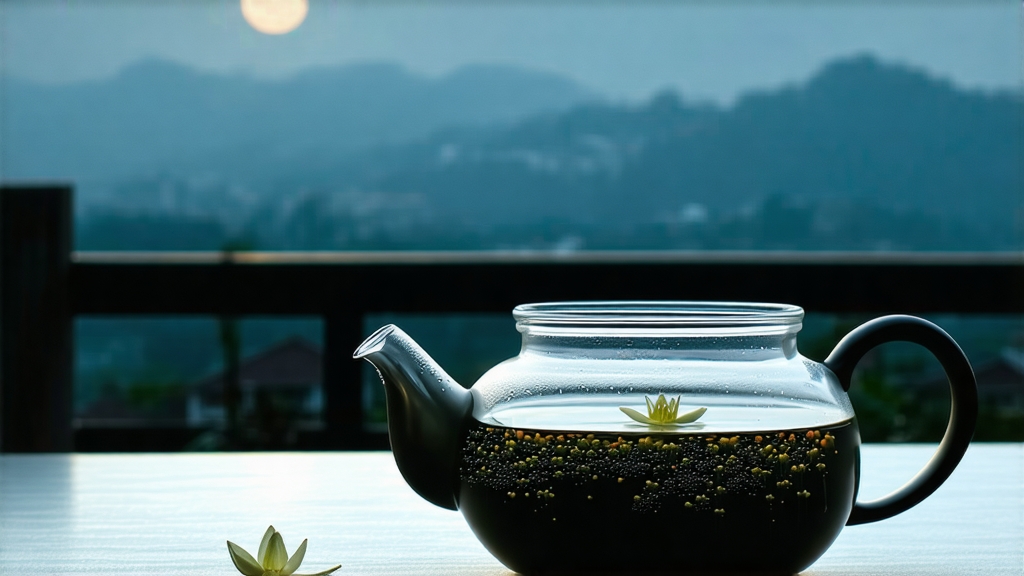
If green tea is the exuberant youth of Chinese tea culture and pu-erh its venerable elder, then Bai Hao Yin Zhen—literally “White Hair Silver Needle”—is the culture’s moonlit poet: quiet, luminous, and insistently refined. International drinkers often meet white tea through generic “silver needle” labels, yet the true Yin Zhen from northern Fujian’s coastal hills is a micro-universe of fragrance, history, and craft. This essay invites you to step inside that universe, tracing the cultivar from Tang-dynasty court tribute to the minimalist glass in your hand, decoding the invisible labor that turns a single spring bud into liquid light, and learning how to coax its subtlest aria of flavor without violating its gentle soul.
-
Historical echoes: from secret tribute to global curiosity
The first written record of “white tea” appears in Song-era treatises, but those leaves were compressed cakes of light-colored green tea, not the loose, minimally processed buds we know today. The modern pedigree of Bai Hao Yin Zhen crystallized during the mid-Qing, when improved roadways allowed Fuding and Zhenghe counties to send their early-spring downy buds to the port of Fuzhou and onward to European tea houses. By 1891, foreign merchants were already describing “silvery pointed leaflets that brew a champagne-colored liquor almost without tannic bite,” a tasting note that still holds. Paradoxically, domestic fame lagged; locals prized it mainly as a medicinal cooler for feverish scholars or overheated infants. Only after 2003, when Chinese white teas met Western wellness trends, did Yin Zhen command imperial-level prices—today, top lots at spring auction exceed USD 3,000 per kilogram, a testament to scarcity and to the global romance with low-oxidation, high-antioxidant teas. -
Terroir and cultivar: why Fuding’s seaboard mist matters
Authentic Bai Hao Yin Zhen is forged from two Fujian cultivars—Fuding Da Bai and Fuding Da Hao—whose leaves carry an unusually dense layer of protective trichomes, the “white hairs” that glint like frost. Grown between 200–800 m on red granite soils, the bushes benefit from a maritime climate: morning fog slows photosynthesis, stockpiling amino acids that translate into sweet, marine umami. A neighboring county, Zhenghe, also produces silver-needle-style tea, but its higher elevation and continental air yield a slightly darker bud with more pronounced cocoa notes; purists debate its legitimacy, yet both styles share the same minimal processing philosophy. What neither region tolerates is rainfall during the critical picking window—buds must arrive at the withering barn pristine, never washed by a shower that would erase their fragrance before it forms. -
The craft of “doing nothing”: a choreography of air and time
Unlike green tea, whose character is fixed by a quick blast of pan heat, Yin Zhen is coaxed into being through negative space. Picking begins when the morning dew still beads on buds that have not yet unfurled into leaves—only the terminal 2.5 cm are plucked, using a twisting motion that avoids the fingernail’s oxidizing bruise. A skilled picker gathers barely 500 g of fresh buds per day, the first reason for its price. The buds are then spread, never piled deeper than 2 cm, on bamboo trays stacked like breathable shelves inside a sun-warmed loft. For 36–48 hours they rest, losing moisture in slow motion while ambient enzymes nudge the leaf chemistry toward a whisper of oxidation—never above 8 %. The master’s secret lies in reading the barn: if the outdoor humidity spikes, windows close and gentle heated air (never above 32 °C) circulates; should the sun glare too fiercely, reed mats filter the light. Finally, a cautious 10-minute bake at 40 °C lowers residual moisture to 5 %, halting change without imprinting roast. The result is a tea that tastes uncannily like its fresh bud: lilac, cucumber skin, and a trace of rock sugar. -
Grading the moonlight: how to recognize authentic needles
Appearance: uniform needle length (2–3 cm), ivory to platinum color, buds slightly curved like miniature fishing hooks. Touch: dry yet cool, the trichomes should dust your fingertips without clumping—an indicator of proper drying. A